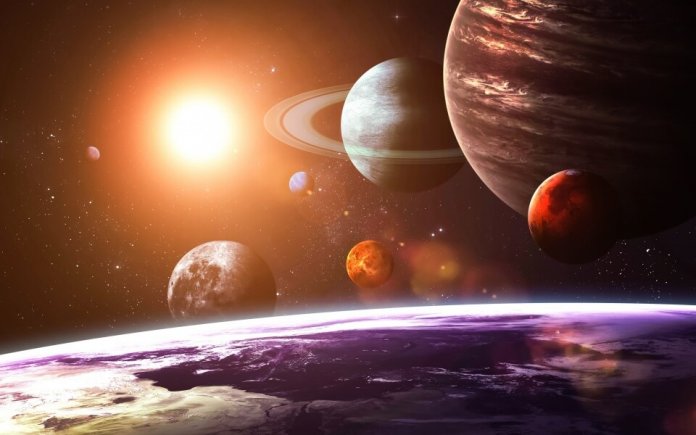To determine how large a planet is, you need to consider criteria such as its mass and diameter. The largest planet in the solar system is 300 times larger than Earth, and its diameter is eleven times larger than that of the earth. For a list of the largest planets in the solar system, their names, sizes, photos and what they are known for, read our rating.
Comparative table of characteristics of planets
Diameter, mass, length of day and orbital radius are indicated relative to the Earth.
| Planet | Diameter | Weight | Orbital radius, a. e. | Orbital period, earth years | Day | Density, kg / m³ | Satellites |
|---|---|---|---|---|---|---|---|
| Mercury | 0.382 | 0.055 | 0.38 | 0.241 | 58.6 | 5427 | 0 |
| Venus | 0.949 | 0.815 | 0.72 | 0.615 | 243 | 5243 | 0 |
| Land | 1 | 1 | 1 | 1 | 1 | 5515 | 1 |
| Mars | 0.53 | 0.107 | 1.52 | 1.88 | 1.03 | 3933 | 2 |
| Jupiter | 11.2 | 318 | 5.2 | 11.86 | 0.414 | 1326 | 69 |
| Saturn | 9.41 | 95 | 9.54 | 29.46 | 0.426 | 687 | 62 |
| Uranus | 3.98 | 14.6 | 19.22 | 84.01 | 0.718 | 1270 | 27 |
| Neptune | 3.81 | 17.2 | 30.06 | 164.79 | 0.671 | 1638 | 14 |
| Pluto | 0.186 | 0.0022 | 39.2 | 248.09 | 6.387 | 1860 | 5 |
9. Pluto, diameter ∼ 2370 km
 Pluto is the second largest dwarf planet in the solar system after Ceres. Even when it was one of the full-fledged planets, it was far from the largest of them, since its mass is equal to 1/6 the mass of the Moon. Pluto has a diameter of 2,370 km and is composed of rock and ice. It is not surprising that it is rather cold on its surface - minus 230 ° С
Pluto is the second largest dwarf planet in the solar system after Ceres. Even when it was one of the full-fledged planets, it was far from the largest of them, since its mass is equal to 1/6 the mass of the Moon. Pluto has a diameter of 2,370 km and is composed of rock and ice. It is not surprising that it is rather cold on its surface - minus 230 ° С
8.Mercury ∼ 4,879 km
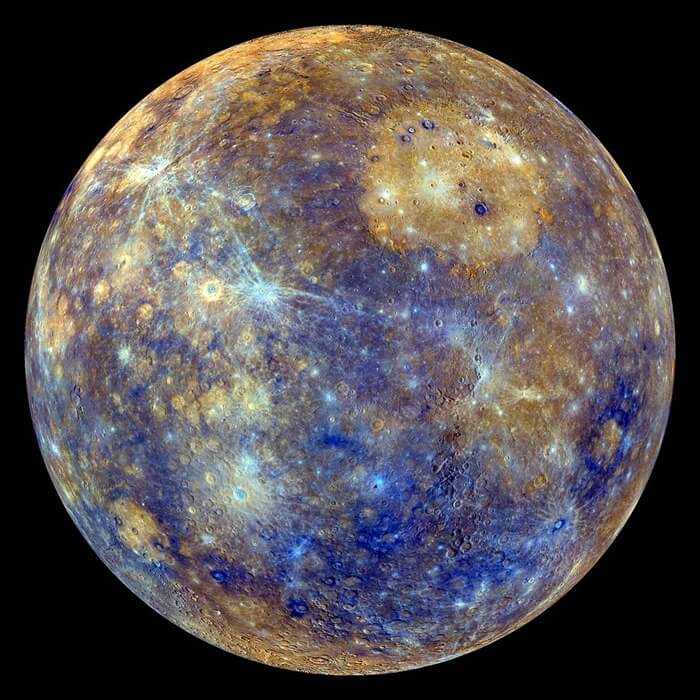 A tiny world with a mass almost twenty times less than the mass of the Earth, and a diameter of 2 ½ less than the Earth. In fact, Mercury is closer in size to the Moon than to Earth and is considered the smallest of the planets in the solar system today. Mercury has a rocky surface dotted with craters. Recently, the Messenger spacecraft confirmed that there is ice water in deep craters on the eternally shrouded side of Mercury.
A tiny world with a mass almost twenty times less than the mass of the Earth, and a diameter of 2 ½ less than the Earth. In fact, Mercury is closer in size to the Moon than to Earth and is considered the smallest of the planets in the solar system today. Mercury has a rocky surface dotted with craters. Recently, the Messenger spacecraft confirmed that there is ice water in deep craters on the eternally shrouded side of Mercury.
7. Mars ∼ 6 792 km
 Mars is about half the size of Earth and has a diameter of 6,792 km. However, its mass is only a tenth of the earth's. This not too large planet in the solar system, the fourth closest to the Sun, has a rotation axis tilt of 25.1 degrees. Thanks to this, the seasons change on it, like on Earth. A day (sol) on Mars is equal to 24 hours and 40 minutes. In the southern hemisphere, summers are hot, and winters are cold, but in the northern hemisphere there are no such sharp contrasts, both summer and winter are mild. We can say that the ideal conditions for building a greenhouse and growing potatoes.
Mars is about half the size of Earth and has a diameter of 6,792 km. However, its mass is only a tenth of the earth's. This not too large planet in the solar system, the fourth closest to the Sun, has a rotation axis tilt of 25.1 degrees. Thanks to this, the seasons change on it, like on Earth. A day (sol) on Mars is equal to 24 hours and 40 minutes. In the southern hemisphere, summers are hot, and winters are cold, but in the northern hemisphere there are no such sharp contrasts, both summer and winter are mild. We can say that the ideal conditions for building a greenhouse and growing potatoes.
6. Venus ∼ 12,100 km
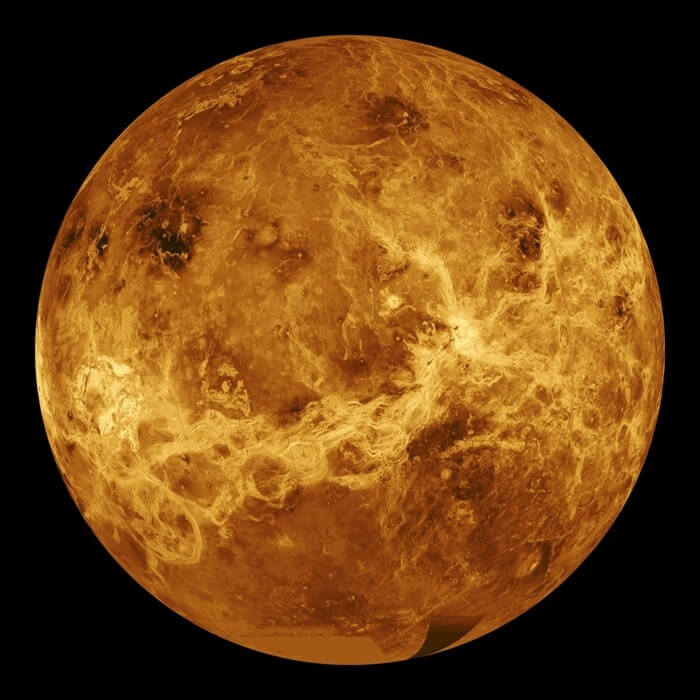 In sixth place in the ranking of the largest and smallest planets is a celestial body named after the goddess of beauty. It is so close to the Sun that it appears first in the evening and disappears last in the morning. Therefore Venus has long been known as the "evening star" and "morning star". It has a diameter of 12,100 km, it is almost comparable to the size of the Earth (1000 km less), and 80% of the mass of the Earth.
In sixth place in the ranking of the largest and smallest planets is a celestial body named after the goddess of beauty. It is so close to the Sun that it appears first in the evening and disappears last in the morning. Therefore Venus has long been known as the "evening star" and "morning star". It has a diameter of 12,100 km, it is almost comparable to the size of the Earth (1000 km less), and 80% of the mass of the Earth.
The surface of Venus is predominantly composed of large plains of volcanic origin, the rest of the giant mountains. The atmosphere is composed of carbon dioxide, with thick clouds of sulfur dioxide. This atmosphere has the strongest greenhouse effect known in the solar system, and the temperature on Venus is kept at around 460 degrees.
5.Earth ∼ 12,742 km
 The third planet closest to the Sun. Earth is the only planet in the solar system that has life. It has an axis tilt of 23.4 degrees, its diameter is 12,742 km, and its mass is 5.972 septillion kg.
The third planet closest to the Sun. Earth is the only planet in the solar system that has life. It has an axis tilt of 23.4 degrees, its diameter is 12,742 km, and its mass is 5.972 septillion kg.
The age of our planet is very respectable - 4.54 billion years. And most of this time it is accompanied by a natural satellite - the Moon. It is believed that the Moon was formed when a large celestial body, namely Mars, impacted the Earth, causing enough material to be ejected for the Moon to form. The moon has a stabilizing effect on the tilt of the Earth's axis and is the source of the ebb and flow of the oceans.
“It is rather inappropriate to call this planet Earth when it is obvious that it is the Ocean” - Arthur Clarke.
4. Neptune ∼ 49,000 km
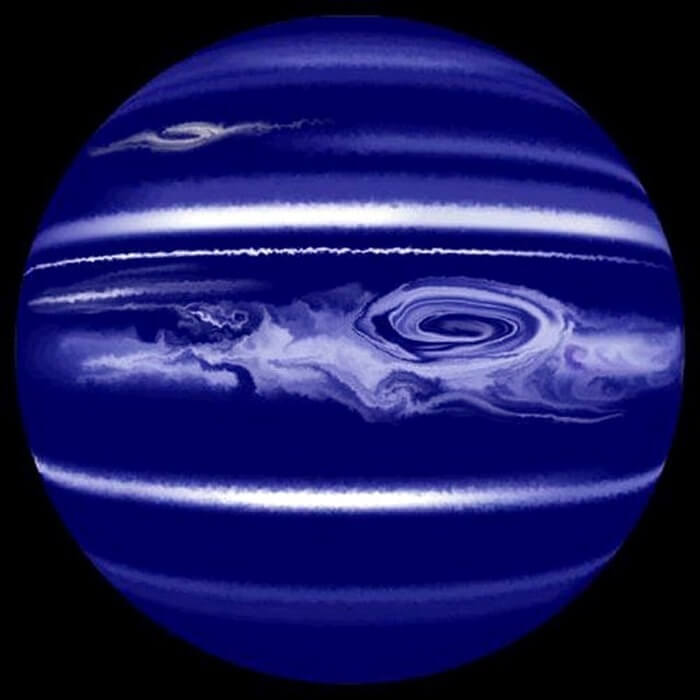 The gas giant planet of the solar system is the eighth celestial body closest to the sun. The diameter of Neptune is 49,000 km, and its mass is 17 times that of Earth. It has powerful cloud strips (they were photographed by Voyager 2 together with storms and cyclones). Wind speed on Neptune reaches 600 m / s. Due to its great distance from the Sun, the planet is one of the coldest, with temperatures in the upper atmosphere reaching minus 220 degrees Celsius.
The gas giant planet of the solar system is the eighth celestial body closest to the sun. The diameter of Neptune is 49,000 km, and its mass is 17 times that of Earth. It has powerful cloud strips (they were photographed by Voyager 2 together with storms and cyclones). Wind speed on Neptune reaches 600 m / s. Due to its great distance from the Sun, the planet is one of the coldest, with temperatures in the upper atmosphere reaching minus 220 degrees Celsius.
3. Uranus ∼ 50,000 km
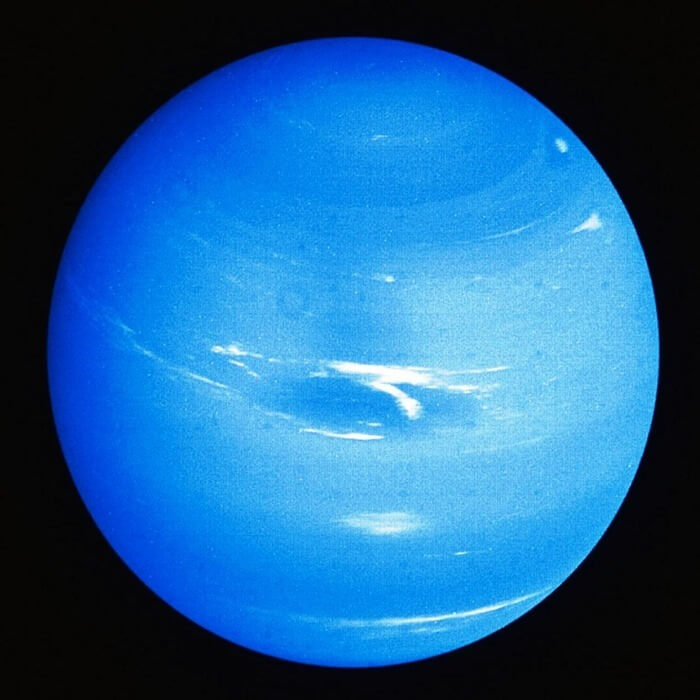 On the third line of the list of the largest planets in the solar system is the seventh closest to the Sun, the third largest and the fourth heaviest of the worlds. The diameter of Uranus (50,000 km) is four times the Earth's, and its mass is 14 times the mass of our planet.
On the third line of the list of the largest planets in the solar system is the seventh closest to the Sun, the third largest and the fourth heaviest of the worlds. The diameter of Uranus (50,000 km) is four times the Earth's, and its mass is 14 times the mass of our planet.
Uranus has 27 known moons with sizes ranging from over 1,500 km to less than 20 km in diameter. The planet's satellites are composed of ice, rocks, and other trace elements. Uranus itself has a rocky core, surrounded by a cover of water, ammonia and methane. The atmosphere is composed of hydrogen, helium and methane with a cloud top.
2. Saturn ∼ 116 400 km
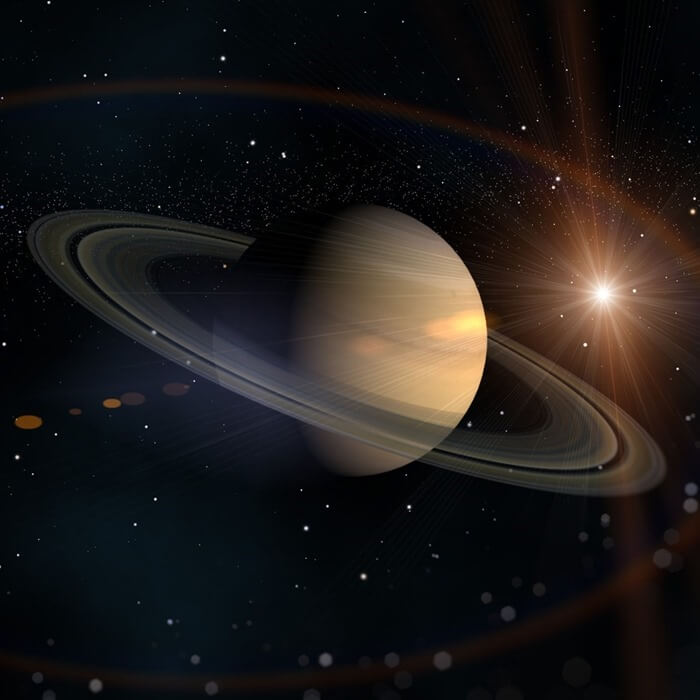 The second of the largest planets in the solar system is known for its ring system. She was first seen by Galileo Galilei in 1610. Galileo believed that Saturn was accompanied by two other planets on either side of it. In 1655, Christian Huygens, using an improved telescope, was able to see Saturn in enough detail to suggest that there were rings around it. They extend from 7,000 km to 120,000 km above the surface of Saturn, which itself has a radius 9 times that of Earth (57,000 km) and a mass 95 times that of Earth.
The second of the largest planets in the solar system is known for its ring system. She was first seen by Galileo Galilei in 1610. Galileo believed that Saturn was accompanied by two other planets on either side of it. In 1655, Christian Huygens, using an improved telescope, was able to see Saturn in enough detail to suggest that there were rings around it. They extend from 7,000 km to 120,000 km above the surface of Saturn, which itself has a radius 9 times that of Earth (57,000 km) and a mass 95 times that of Earth.
1. Jupiter ∼ 142 974 km
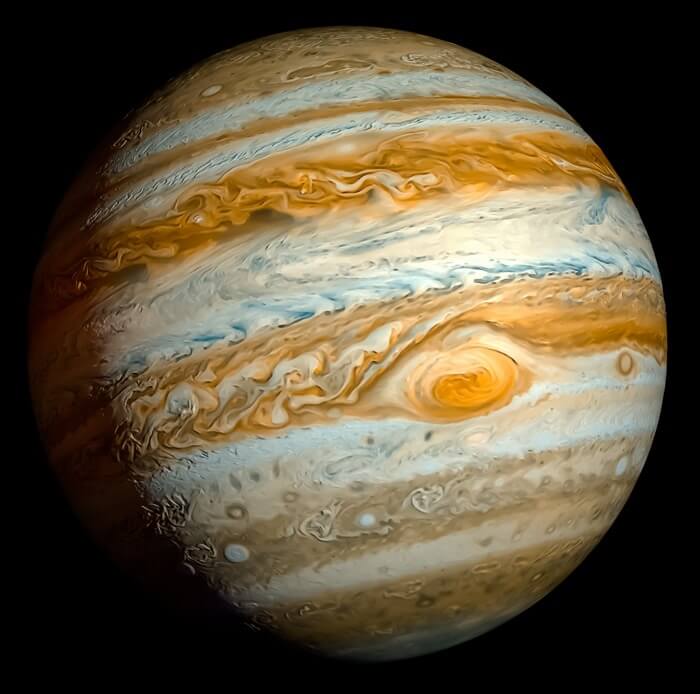 The first number is the winner of the planetary heavy hit parade, Jupiter is the largest planet bearing the name of the Roman king of the gods. One of the five planets visible to the naked eye. It is so massive that it would contain the rest of the worlds of the solar system, minus the sun. Jupiter's total diameter is 142.984 km. Given its size, Jupiter rotates very quickly, making one rotation every 10 hours. There is a fairly large centrifugal force at its equator, due to which the planet has a pronounced hump. That is, the diameter of Jupiter's equator is 9000 km greater than the diameter measured at the poles. As befits a king, Jupiter has many satellites (more than 60), but most of them are quite small (less than 10 km in diameter). The four largest moons, discovered in 1610 by Galileo Galilei, are named after the favorites of Zeus, the Greek counterpart of Jupiter.
The first number is the winner of the planetary heavy hit parade, Jupiter is the largest planet bearing the name of the Roman king of the gods. One of the five planets visible to the naked eye. It is so massive that it would contain the rest of the worlds of the solar system, minus the sun. Jupiter's total diameter is 142.984 km. Given its size, Jupiter rotates very quickly, making one rotation every 10 hours. There is a fairly large centrifugal force at its equator, due to which the planet has a pronounced hump. That is, the diameter of Jupiter's equator is 9000 km greater than the diameter measured at the poles. As befits a king, Jupiter has many satellites (more than 60), but most of them are quite small (less than 10 km in diameter). The four largest moons, discovered in 1610 by Galileo Galilei, are named after the favorites of Zeus, the Greek counterpart of Jupiter.
What is known about Jupiter
Before the invention of the telescope, planets were viewed as objects roaming the sky. Therefore, the word "planet" from Greek is translated as "wanderer". Our solar system has 8 known planets, although originally 9 celestial objects were recognized as planets. In the 1990s, Pluto was "demoted" from being a true planet to being a dwarf planet. AND the largest planet in the solar system is called Jupiter.
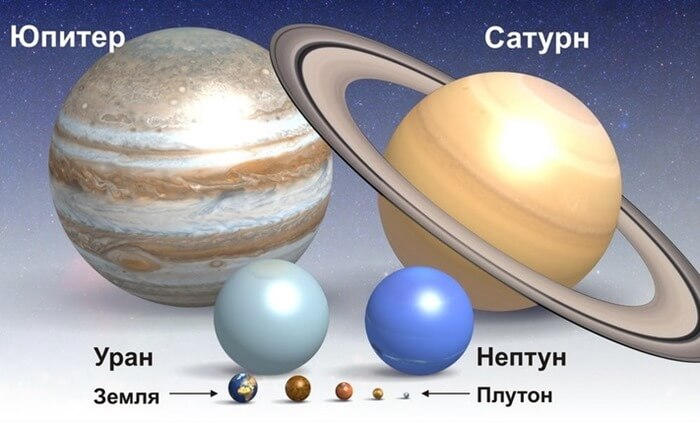
The radius of the planet is 69,911 km.That is, all the largest planets in the solar system could fit inside Jupiter (see photo). And if we take only our Earth, then 1300 such planets will fit inside the body of Jupiter.
This is the fifth planet from the Sun. It is named after a Roman god.
Jupiter's atmosphere is made of gases, mainly helium and hydrogen, which is why it is also called the gas giant of the solar system. Jupiter's surface is composed of an ocean of liquid hydrogen.
Jupiter has the strongest magnetosphere of all other planets, 20,000 times stronger than Earth's magnetosphere.
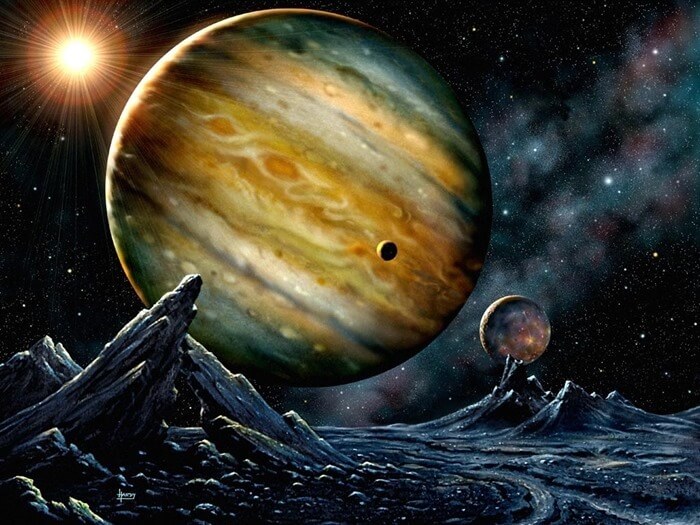 The largest planet in the solar system rotates around its axis faster than all "neighbors". One complete revolution takes just under 10 hours (Earth takes 24 hours). Because of this rapid rotation, Jupiter is convex at the equator and "flattened" at the poles. The planet is 7 percent wider at the equator than at the poles.
The largest planet in the solar system rotates around its axis faster than all "neighbors". One complete revolution takes just under 10 hours (Earth takes 24 hours). Because of this rapid rotation, Jupiter is convex at the equator and "flattened" at the poles. The planet is 7 percent wider at the equator than at the poles.
The largest celestial body in the solar system revolves around the Sun once every 11.86 Earth years.
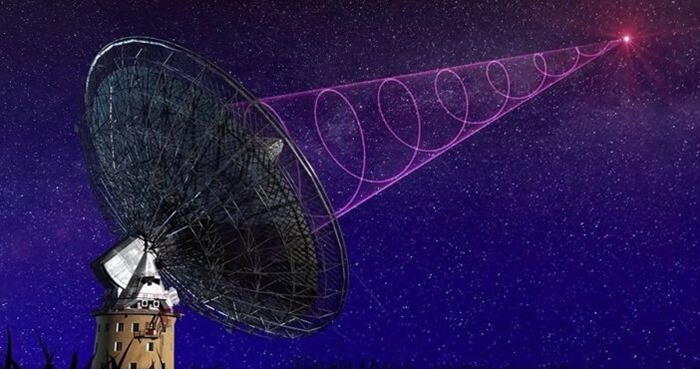 Jupiter transmits radio waves so strong that they can be detected from Earth. They come in two forms:
Jupiter transmits radio waves so strong that they can be detected from Earth. They come in two forms:
- strong bursts that occur when Io, the closest of Jupiter's large moons, passes through certain regions of the planet's magnetic field;
- continuous radiation from the surface and high-energy particles of Jupiter in its radiation belts. These radio waves could help scientists explore the oceans on the space giant's satellites.
Jupiter's most unusual feature
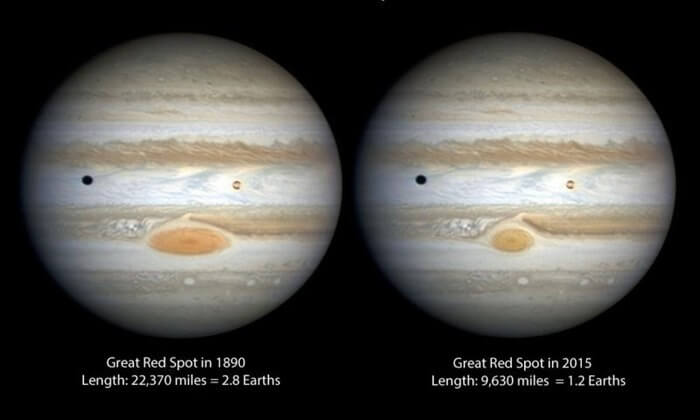
Undoubtedly, the main feature of Jupiter is the Great Red Spot - a giant hurricane that has been raging for over 300 years.
- The diameter of the Great Red Spot is three times the diameter of the Earth, and its edge rotates around the center and counterclockwise at a tremendous speed (360 km per hour).
- The color of the storm, which usually ranges from brick red to light brown, may be due to the presence of small amounts of sulfur and phosphorus.
- The spot increases and decreases over time. One hundred years ago, education was twice as large as it is now and significantly brighter.
There are many other spots on Jupiter, but only in the Southern Hemisphere for some reason they exist for a long time.
Jupiter's rings
 Unlike the rings of Saturn, which are clearly visible from Earth even through small telescopes, Jupiter's rings are very difficult to see. Their existence was revealed by data from Voyager 1 (NASA's spacecraft) in 1979, but their origin was a mystery. Data from the Galileo spacecraft, which revolved around Jupiter from 1995 to 2003, later confirmed that these rings were created by meteoroid impacts on small nearby satellites of the largest planet.
Unlike the rings of Saturn, which are clearly visible from Earth even through small telescopes, Jupiter's rings are very difficult to see. Their existence was revealed by data from Voyager 1 (NASA's spacecraft) in 1979, but their origin was a mystery. Data from the Galileo spacecraft, which revolved around Jupiter from 1995 to 2003, later confirmed that these rings were created by meteoroid impacts on small nearby satellites of the largest planet.
Jupiter's ring system includes:
- halo - inner layer of small particles;
- the main ring is brighter than the other two;
- outer "spider" ring.
The main ring is flattened, its thickness is about 30 km, and its width is 6400 km. The halo extends halfway from the main ring down to the tops of Jupiter's clouds and expands by interacting with the planet's magnetic field. The third ring is known as the spider's ring because of its transparency.
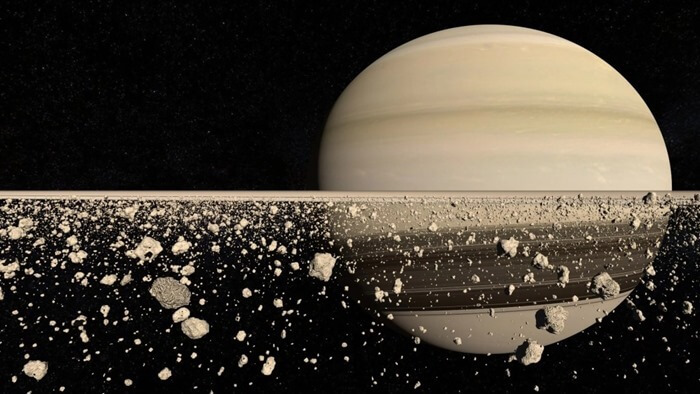 Meteorites striking the surface of Jupiter's small inner moons kick up dust, which then falls into orbit around Jupiter, forming rings.
Meteorites striking the surface of Jupiter's small inner moons kick up dust, which then falls into orbit around Jupiter, forming rings.
Moons of Jupiter
Jupiter has 53 confirmed moons orbiting it, and 14 more unconfirmed moons.
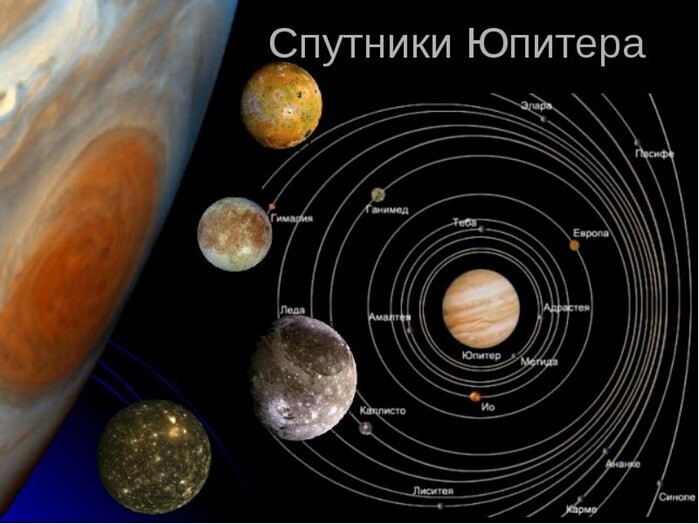 The four largest moons of Jupiter - they are called the Galilean moons - are Io, Ganymede, Europa and Callisto. The honor of their discovery belongs to Galileo Galilei, and this was in 1610. They are named after those close to Zeus (whose Roman counterpart is Jupiter).
The four largest moons of Jupiter - they are called the Galilean moons - are Io, Ganymede, Europa and Callisto. The honor of their discovery belongs to Galileo Galilei, and this was in 1610. They are named after those close to Zeus (whose Roman counterpart is Jupiter).
 Volcanoes rage on Io; there is an under-ice ocean on Europa, and perhaps there is life in it; Ganymede is the largest satellite in the solar system and has its own magnetosphere; and Callisto has the lowest reflectivity of the four Galilean satellites. There is a version that the surface of this moon consists of dark, colorless rock.
Volcanoes rage on Io; there is an under-ice ocean on Europa, and perhaps there is life in it; Ganymede is the largest satellite in the solar system and has its own magnetosphere; and Callisto has the lowest reflectivity of the four Galilean satellites. There is a version that the surface of this moon consists of dark, colorless rock.
Video: Jupiter is the largest planet in the solar system
We hope that we have given a complete answer to the question of which planet in the solar system is the largest!

